Text
Shoebox Adventures- the power of space in Roy Andersson’s “A Pigeon Sat On A Branch Reflecting On Existence”
In 2014, Swedish commercial-maker Roy Anderson tried to bring his school science fair project to the Cannes film festival. A series of solemn set-pieces on the human condition shot in hyper-real grey spaces that simultaneously evoke familiarity and discomfort, his odd little diorama was bound to make a storm.
Except Cannes rejected it.
But Venice let it in! And thank god they did, saving this cinematic gem from public negligence and (a mere 6 years later) bringing it to my attention! “A Pigeon”, as I will now be referring to it, is almost certainly the strangest film I have ever seen. It might also be one of the most wonderful, thought-provoking and funny films as well. Characters, plot and setting are largely absent or deliberately vague, instead thrown in the all-consuming mixing pot known as ‘mood’. But when you’re telling a story about the nuances and complexities of humanity, it seems stupid to make it like a story. Much of it is left for the viewer to assert their own personal interpretations, to feel what they feel from the film’s peculiar exhibits. Not because “A Pigeon” has set out to confuse or provoke different audiences, but because different people see life differently. And this film has something for those different views. Who knows, it might even help them live alongside one another.
As part of my recent architectural fad, I thought this would be a great chance to explore the power of spaces within films, which is probably the medium in which we consume the largest quantity and variety of architecture. What Anderson has done with his little spaces is all kinds of captivating. Natural and alien, his scenes grow and decay off the tiniest differences. Now, to work!.
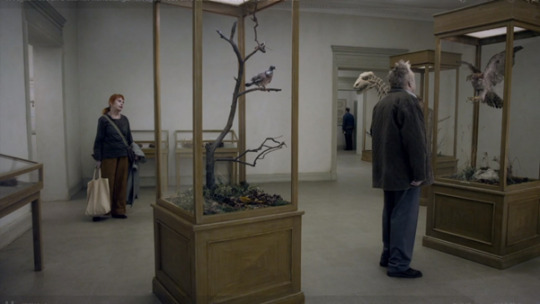
The opening scene puts everything on the table as to what we’re in for. Peering at a talcum powdered women scolding a talcum powdered man peering at stuffed birds in the world’s greyest museum, accompanied by plinky strings, you can already tell this isn’t going to infringe on The Fast and the Furious’ turf. The camera sticks 10 feet back from the ‘action’ and never once zooms or pans, so we can continually survey the scene without any distracting close-ups, leaving the characters spied-on but not fully known. The open doorways and windows are everpresent throughout the movie, a clever trick to alleviate feelings of claustrophobia. This also serves to give us a view to equally stately goings-on in the background, which helps to create Andersson’s diorama world. Every wall is flat in colour and texture, the lighting uniformly gloomy with no hint of natural light or shadow. And the cages that hold the taxidermy are metaphors for our cages of loneliness in the modern world, but you knew that already.

This hospital scene starts out as static, a painting-like arrangement of a classic scene, the children witnessing the gradual passing of their mother. Andersson keeps it uncluttered by having the dialogue occur two doorways away.
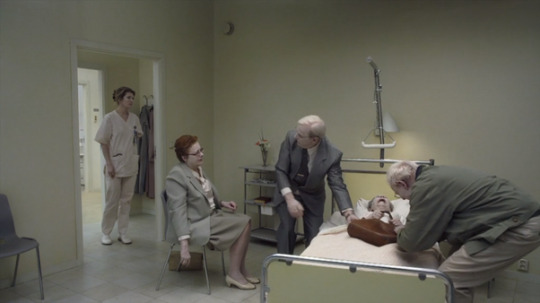
And yet after pleasantries are dispatched and pretence discarded, the whole scene swirls like Vertigo; the brothers contort, the sister slumps in her chair, the presumed-still body of the mother’s body squawks out in alarm as her bed is dragged sideways across the room. We do not zoom in to see her anguished face, making her all the more powerless and the viewer confused at what to feel. The nurse arrives silently at the threshold, hesitant to cross into this family’s hysteria. She watches the painting come to life and ruin itself, just as we do. The notion of characters watching characters is one that Andersson returns to a lot in “A Pigeon”, which ultimately provides a heavy dose of the film’s realism. In traditionally-shot movies, the two-way dialogue close-ups obscure the silent characters from our interest. Andersson lets us see them gawp, knowing we do too.
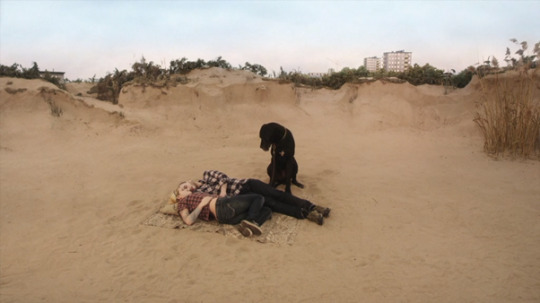
A romantic getaway might seem like a departure from the film’s predominantly urban setting, but whilst the sand and soundtrack provides the impression of a beach-scene, we are actually in another of Andersson’s dioramas. The intimacy of the couple is uncomfortable, and not just for the man’s awkward movements or their judging dog. The wall-like dunes rise up, obscuring the horizon as a pair of far-off high rises intrusively leer into shot. The sky is a pastel blue, withholding any sense of time or importance on the moment we’re presented with, the mutt our audience sleeper agent who stiffly watches it unfold.

The closest the film gets to any main characters are a pair of grey-clad salesmen who potter about the scenes with mixed financial success. Throughout the film we get to know them, and thus Sam and Jonathan carry the largest targets on their back for Andersson’s gentle ridicule, here pictured bursting into the bar like outlaws into a wild-west saloon, in which they explain that they’ve gotten lost looking for a mythical shop named ‘Party’. The gorgeous painted background, viewed through a window, is our first glimpse of a horizon- a grey/green wasteland dominated by gargantuan transmission towers. our heroes have traversed this wilderness, by foot or car we are never told, to find the Party and reap the rewards! Unfortunately for them such a place does not appear to exist, and fortunately for us they are cut off from their usual sales pitch by the arrival of the army of King Charles XII.
You need to go and watch it!
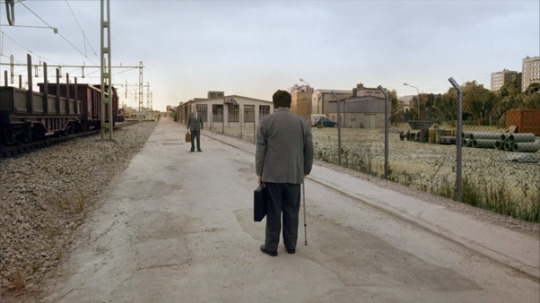
Sam and Jonathan’s spaghetti western (perhaps Swedish meatball western?) journey is revived somewhat later, with what looks like a briefcase-wielding standoff inexplicably located next to a railway. This normally charged setting is relieved of all potency by their slow hobbling around the mid-ground, exchanging insults and emptying briefcases. Which makes it more pathetic, more silly and more real. Probably the three words I’d use to describe the film.

The cruelty sequence of the film begins in a stark grey laboratory. A monkey is hooked up to electrodes and shocked according to a time. The scientist talks vapidly on the phone. In the room behind another technician feeds the remaining inmates. The monkey is closer to the camera than almost any other character through ‘A Pigeon’, close enough to see it writhe. Out the window are more grey high-rise buildings, now somewhat more suspicious and responsible for the monkey’s torture. Andersson’s world is the same palette and yet it’s ever-changing, the mood altering with each new skit. The monkey has nowhere in the film to escape to, you can’t imagine a happy ending for it and thus it’s the most blatant moraliser of the film (until the next scene).

The scene in question witnesses African slaves forced by British colonial soldiers to march into a giant cylindrical drum with horns protruding out. It’s then set alight, and we squirm as it spins, implying the frantic scrambling of those inside to produce a resonant rumble while we watch from a safe distance. I won’t spoil what happens next, but it’s sufficiently sobering.
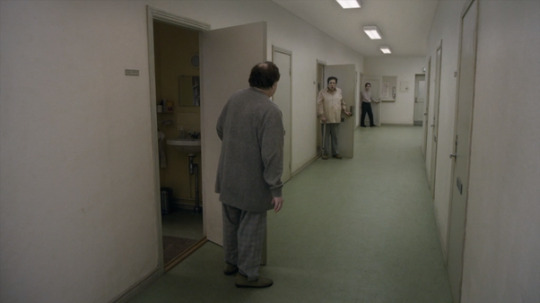
Waking from this horrible dream, Jonathan wails to Sam to make sure the viewer got the point the point of this sequence- “Is it right to benefit from the pain of others?”. Andersson makes his plea the more pathetic and powerful by giving us a view to his sink and mirror, the latter a reminder of his role in the pain.
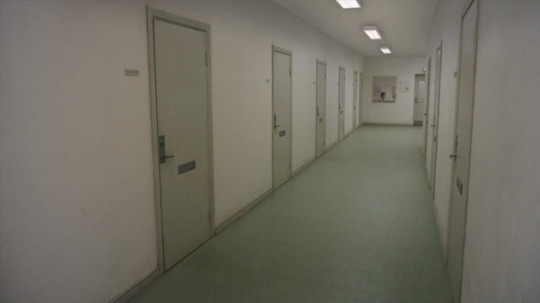
Once Jonathan is told to go back to sleep, the camera stays resolutely on the corridor. It is a bizarre space. The flat doors defy depth, the corridor is long yet finite, grubby yet sterile, lonely yet constantly surveyed by the permanently grumpy security guard.
i hope you enjoyed this dip into “A Pigeon”, and I say dip because there’s about 39 scenes in total and I wasn’t going to do all of them (for free *wink wink*). I thoroughly recommend that you watch this film (and currently you can for free on all4 in the UK) and then maybe re-watch it two more times. You may not like much of it, some of it or most of it. But I think you will love part of it. And that can be your bit of it, to take to parties and share with everyone else. Because like the hokey cokey, that’s what it’s all about.
2 notes
·
View notes